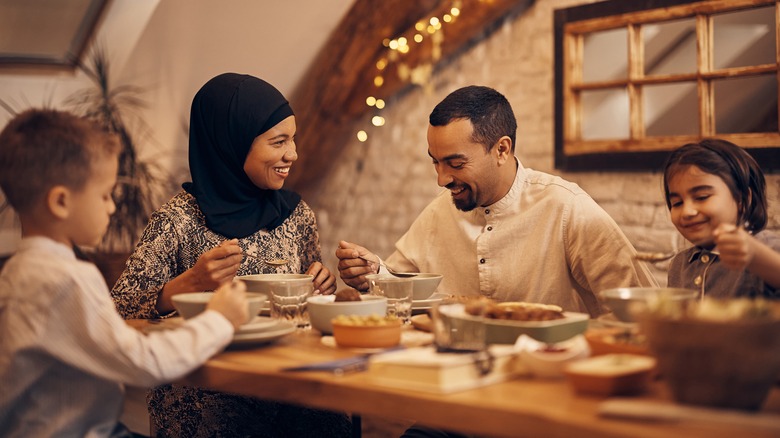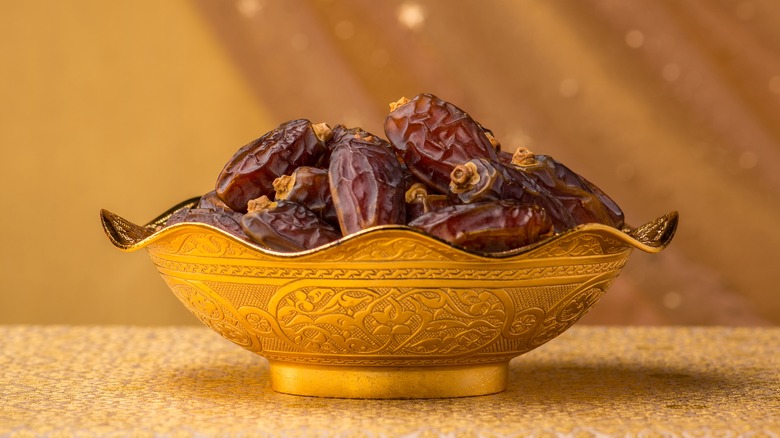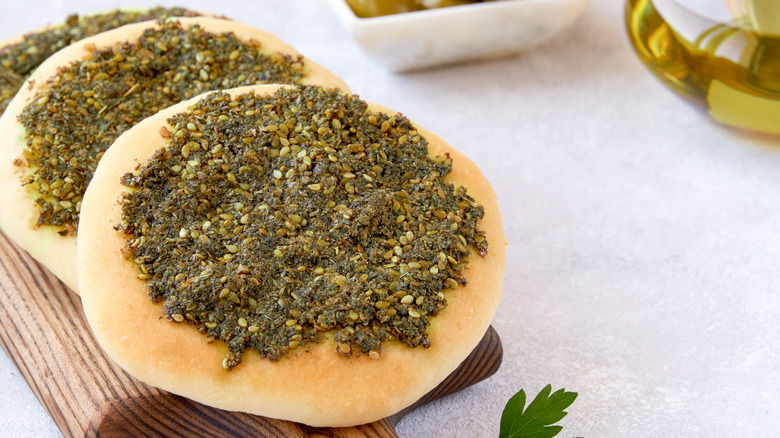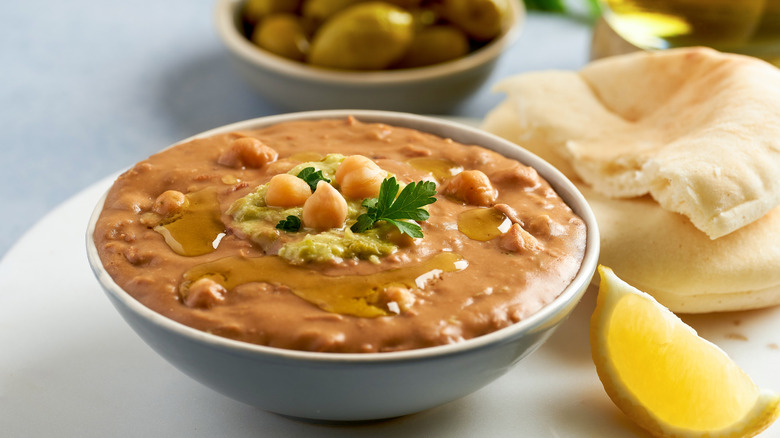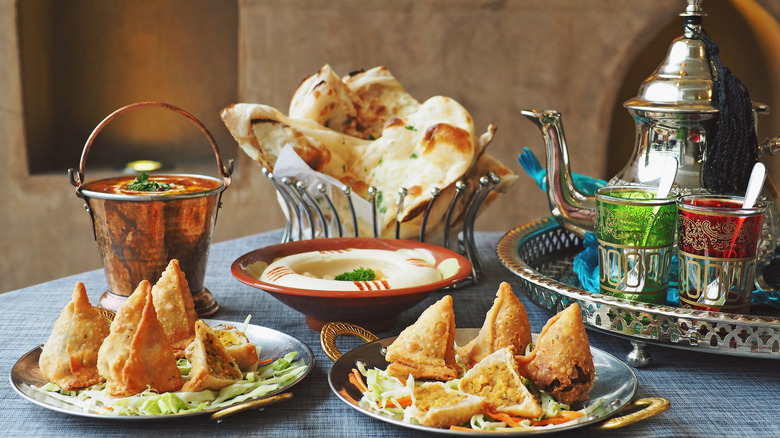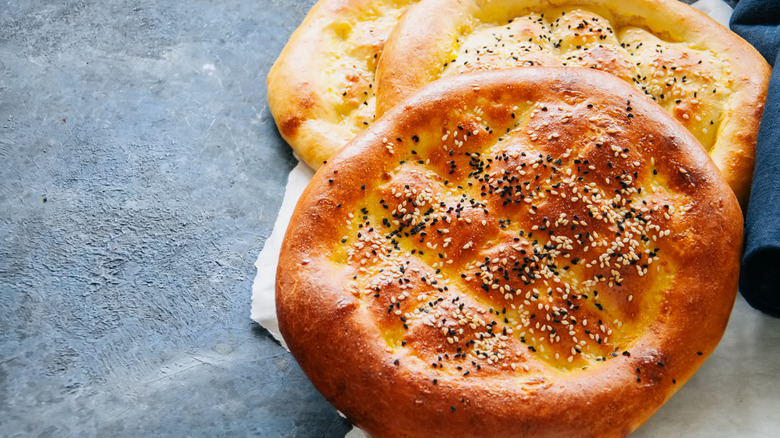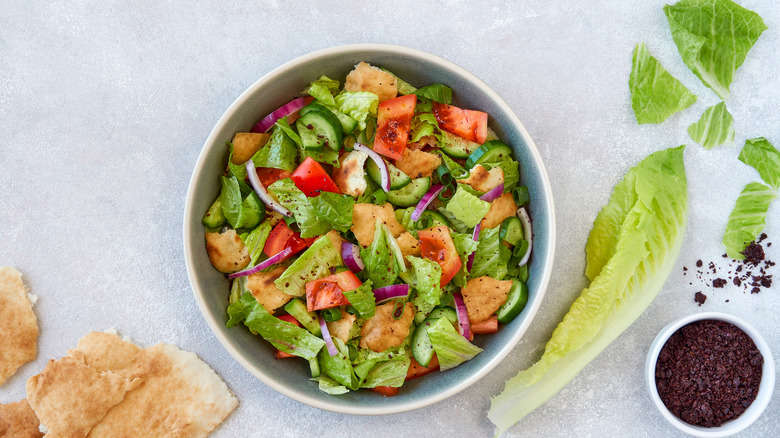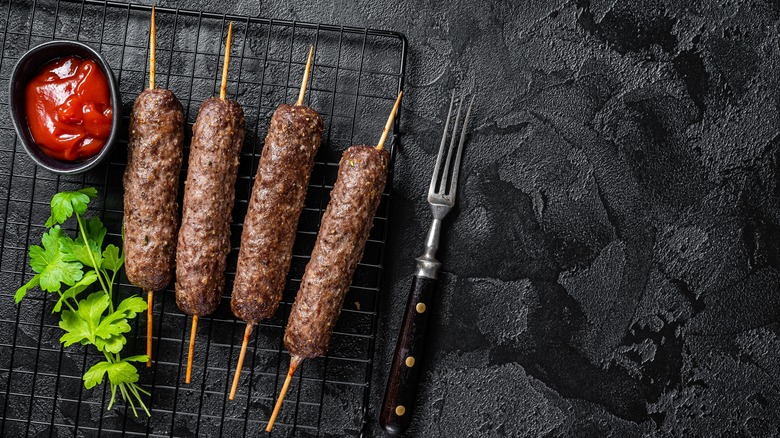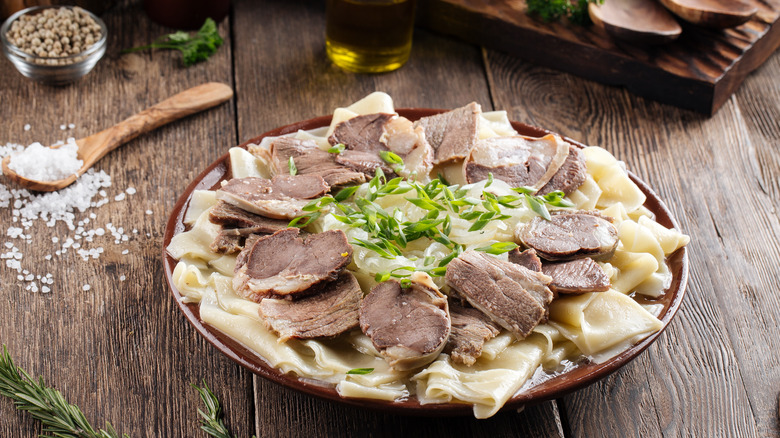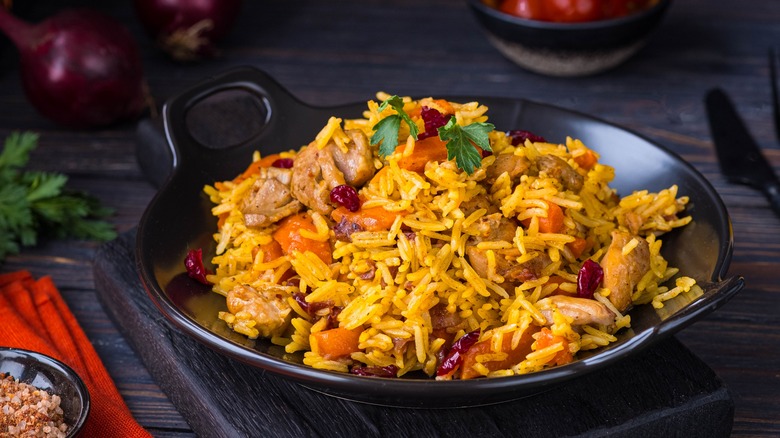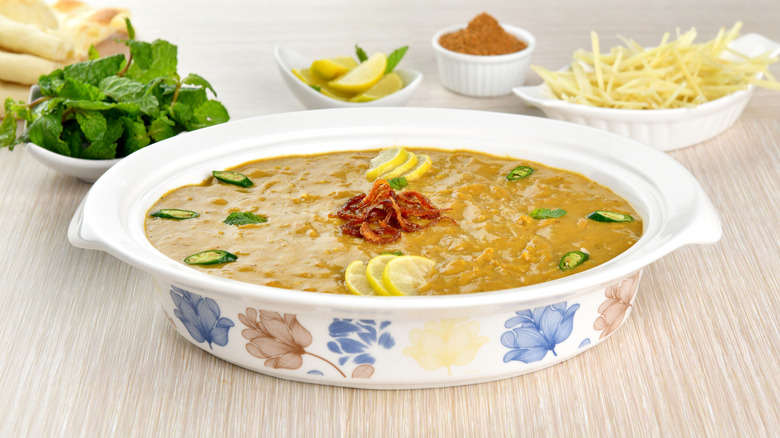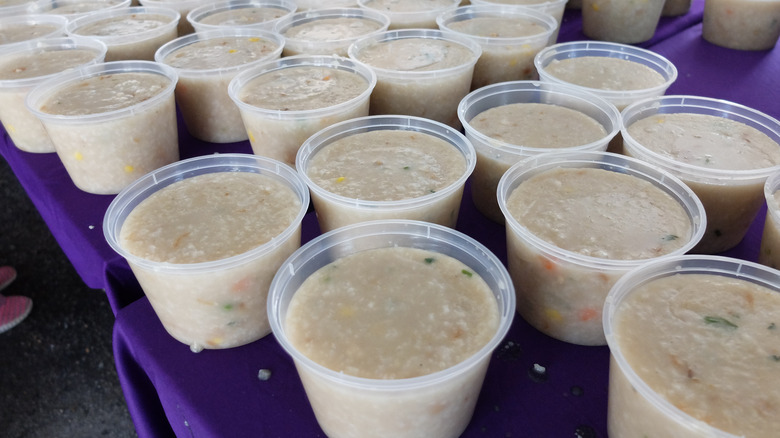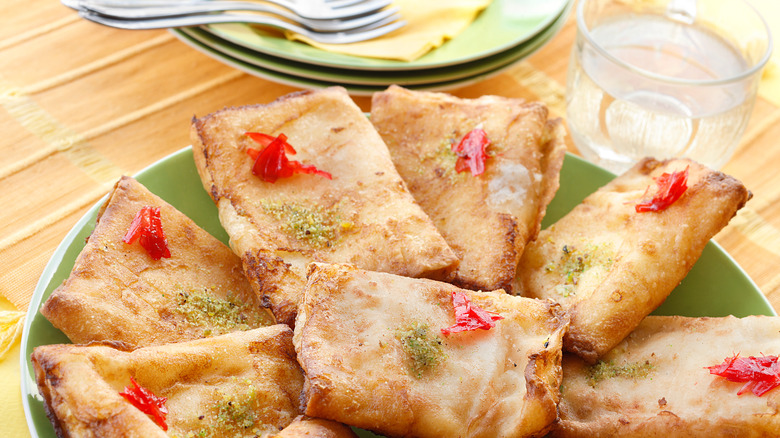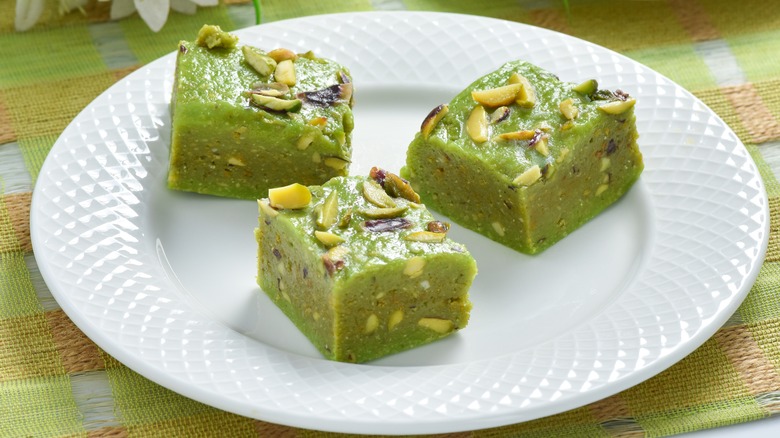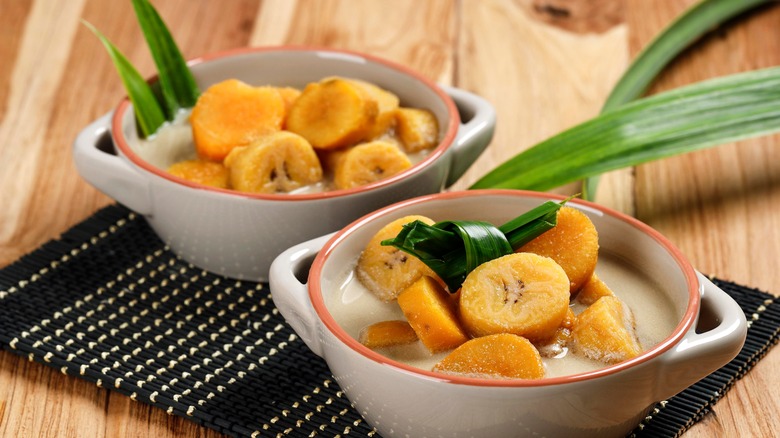Foods To Eat During Ramadan
Ramadan, the ninth month of the lunar Muslim calendar, is a time of fasting for the faithful. As Britannica explains, the Night of Power occurred sometime during the last 10 days of Ramadan, when the Prophet Muhammad is said to have received Islam's holy book, the Quran, from God. Since then, Muslims all over the world have devoted the entire month of Ramadan to reading the Quran, praying, self-reflecting, and, perhaps most memorable to outside observers, fasting. This does not mean that adherents do not eat for 30 days. That would be dangerous. In fact, two meals are eaten per day, just not during daylight hours (young children and people with certain health conditions may abstain from fasting).
Suhoor is the morning meal, which is eaten before dawn, that provides the body the nutrition it needs for the upcoming fast. According to The Quran Recital, eating suhoor helps to regulate one's blood sugar levels and benefits digestion, fending off potential stomach issues that may arise before the end-of-day meal called iftar. Iftar is the evening meal eaten at sunset that breaks the daily fast.
Because Muslims can be found in nearly every country and culture across the globe, the traditions around these meals vary from simple to elaborate. While many cultures share similar foods eaten during Ramadan, others are unique to their specific locations. Read on to learn more about what kinds of foods Muslims around the world like to eat during Ramadan.
Dates
Native to the Middle East and northern Africa, dates are perhaps the most ubiquitous food across the Muslim world, especially during Ramadan. "Dates were one of Prophet Muhammad's favorite and most desired food items," Dr. Nisar Ahmed Bathoolunnisa, manager of dietetics at Sheikh Shakhbout Medical City, told Gulf News. "It is customary in many countries for Muslims to break their fast at the time of iftar by consuming dates as it is [considered to be a] blessed practice based on the [example] of Prophet Muhammad."
Dates are also packed with nutrition, including high levels of fiber, antioxidants, and various vitamins and minerals such as copper (per Healthline). Dates also contribute to regulating blood sugar levels and maintaining healthy bones. And they are naturally quite sweet. "Dates can satisfy a person's sweet tooth while also providing essential nutrients, such as vitamin B-6 and iron," Dr. Bathoolunnisa said, cautioning that "people with diabetes should be mindful of their total sugar intake when consuming dates."
This traditionally dried fruit can be eaten alone or used in desserts as well as savory dishes.
Manakeesh za'atar
Lebanese Manakeesh (sometimes spelled manakish) is a type of yeasted flatbread that can be topped with a variety of ingredients, similar to a pizza. Sometimes it is even called Lebanese pizza. Arab News explains that manakeesh dates back to at least the 10th century, and its recipe has remained relatively unchanged in all that time. One version called manakeesh za'atar is topped by, you guessed it, za'atar, a blend of herbs and spices that can be used in many dishes. Za'atar typically includes dried oregano, thyme, marjoram, sumac, and toasted sesame seeds, though there are many variations.
For manakeesh za'atar, the za'atar is mixed with olive oil and spread onto the dough before baking. Asma Aldaghar, who lived in Dubai, shared on Berkeley Lab's Global ERG that for Ramadan she makes manakeesh za'atar with "mint, olives, and cucumber for garnish." On YouTube, Hoda Hannaway explained how she tops her manakeesh with cheese, onions, mushrooms, and pepperoni, ingredients that are familiar to many Westerners. She suggests having manakeesh for suhoor, but it can be eaten at any time. Manakeesh is something that can be made to suit anyone's fancy.
Fava beans
Fava beans are an important part of the Egyptian diet. The news site Egypt Independent reported in April 2021 that the country's consumption of fava beans nearly triples during the month of Ramadan compared with other months of the year.
These beans are used to make one of Egypt's traditional breakfast dishes called ful medames (sometimes spelled as foul medames) as well as taameya, the Egyptian variety of falafel. The nutrient-rich broad beans are high in fiber and a good source of protein, and they may have several health benefits. This makes them very useful during a time of fasting.
"In Egypt and Sudan, foul is a mainstay because it is high in protein and it's highly affordable, so that makes it accessible to a lot of people," recipe contributor Ahmed El Gaili told The National in 2021. "During Ramadan, it's almost a requirement to have foul (ful) for every iftar –- it's a bit heavy for suhoor."
Samosas
The samosa began its life far from India, where it is practically iconic today. The pastry, which is stuffed with a variety of ingredients and then fried, traces its roots to Persia, where it was originally called "sanbosag" and later evolved into the more familiar word we use today. These crispy, savory snacks are enjoyed all over the world, so it is little wonder that they are found on so many iftar tables.
Samaiya Mushtaq wrote in The Dallas Morning News that samosas "are a staple of Ramadan in Pakistani culture" and something she looked forward to every year when she was a child. Mehar Ahmad recalled in an article for Australian Muslim Times the happy memories from growing up in what is now known as Bangladesh. She also suggested that those who prefer not to eat the more calorie-dense fried samosas should try popping them in the oven or an air-fryer instead. A quick and easy alternative to making the dough from scratch is to use premade sheets of spring roll wrappers or puff pastry.
Ramazan pidesi
Ramadan pita is known by Muslims in Turkey as Ramazan pidesi, a chewy, round flatbread similar to focaccia that is topped with sesame seeds and nigella seeds. The dough has lines sliced into the top that make it tearable and shareable once it's baked.
According to food writer Vidar Bergum, the people of Turkey have had a tight relationship with bread that likely dates to the very first known cultivated wheat fields located along the country's modern border with Syria.
While Ramazan pidesi can be baked at home, it is also available in Turkish bakeries, where you might wait in line for hours to buy a loaf. According to Do You Know Turkey, during the time of the Ottoman Empire, people bought the ingredients for the bread then lined up in front of the local bakeries "to see the preparation of the pita with their own eyes." The blog Turkey's For Life reported that even non-Muslims continue to participate in this queueing tradition, relishing the aroma and flavor of still-warm bread fresh from the bakeries.
Fattoush
Fattoush is a Levantine chopped salad topped with crunchy bits of pita bread that act the same as croutons. According to The Mediterranean Dish, using these leftover pieces of day-old pita was a way to not waste food. The vegetables used also vary by location and culture and are often based on what's in season at the time. Typical ingredients include lettuce, tomatoes, cucumbers, onions, and radishes, but different recipes may leave out any one of those items, including the lettuce. Sumac, or more precisely the spice made from ground sumac berries, is a key ingredient either alone or as part of a za'atar spice blend. The dressing is usually oil-based.
Fattoush is commonly found on Levantine iftar tables as well as the feast that ends the month of fasting. The salad is light and nutritious. Sumac has anti-inflammatory and antioxidant properties, according to a 2014 study in the Iranian Journal of Pharmaceutical Research. Tomatoes, radishes, and cucumbers used in the salad also have multiple health benefits.
Kebabs
Like samosas, kebabs are a nearly universally enjoyed food. (Incidentally, according to Britannica, the name for these tasty skewers of grilled meat also came from Persia.) Kebabs, with their high protein content, are a great addition to any iftar table. Between the meat and the spices, there is so much variety to kebabs!
Fine Dining Lovers listed several different types of kebabs to try during Ramadan, from the more traditional lamb kebabs paired with tabbouleh or spinach salad to chicken kebabs flavored with a barbecue marinade. Kebabs can also be made with fish or beef. Muslims in South Africa might enjoy sosaties, that region's take on kebabs made with curried meat. Those in South Asia may find their mouths watering for seekh kebabs, which are made with minced meat mixed with spices rather than cubes of meat, according to Procaffenation.
Vegans and vegetarians may prefer eggplant kebabs or skewers made with another meat alternative. As explained by About Islam, Muslims do not eat pork, so while others may enjoy pork kebabs, few people will be breaking their fast with them.
Beshbarmak
Beshbarmak is a simple dish of noodles, boiled meat, and onion. According to Daily News Egypt, among Kazakh people, the meat is not seasoned because it is believed that the inherent flavors of the meat are what should be enjoyed. Many different meats, including horse, beef, lamb, camel, and goose, were traditionally used to make this dish, but today beef and lamb are quite common. The noodles tend to be broad, kind of like lasagna noodles.
The dish can seem a little greasy to those who aren't used to it, and beshbarmak is sometimes made with leaner meat to suit Western tastes. But in generations past, the energy provided by fattier meat was important to people's diets, and many Kazakhs still make beshbarmak with fattier meat such as the hindquarters of a ram or horse.
The name beshbarmak translates into English as "five fingers." Experts say this is a reference to how the dish is traditionally eaten, using one's fingers, or because the meat is cut by hand.
Pilaf
Did you know that, according to Britannica, nearly 50% of the earth's population eats rice as a staple food? Asia and Africa are the top two producers of rice. So it is no surprise that rice dishes like pilaf (sometimes called pilau or pilaw), made of seasoned rice and often meat and vegetables, feature prominently on many iftar tables.
The dish goes by several other names. In Kazakhstan, it is called plov and made with lamb or beef along with rice, onions, and carrots. According to WOW 360, kabuli pulao, which is made with rice, meat, chickpeas, carrots, raisins, and nuts, is found in Afghanistan as well as parts of Pakistan. Chef Lola's Kitchen made the distinction between Indian pilau, which uses curry, and East African pilau, which does not. Paella is a descendant of pilaf that was brought to the Iberian peninsula from northern Africa by the Moors in the ninth century A.D.
Haleem
For the people of Hyderabad, India, Ramadan brings haleem. This hearty stew of goat meat, lentils, and a blend of spices, is packed with nutrition and protein. Fayaz Farooqui, the media coordinator for his family's chain of restaurants in India known for making the dish, told NPR, "It is like an energy food. I bet I could fast for two days straight if I eat one bowl of haleem." That restaurant chain, Pista House, prepares a distinct version of the dish that has been declared as authentic to that region through the awarding of geographical indication status in 2010 by the Indian government, per NPR.
Vaishak Damodar, a Hindu, told NPR that he eats haleem almost every day of Ramadan. "For me, haleem is a feel-good factor," he said.
Chef Kunal Kapur explained that the roots of haleem, as with many other Ramadan foods on this list, lie in Persia and were brought to India many centuries ago. It bears some resemblance to the Middle Eastern dish harees.
Bubur lambuk
Burbur lambuk is another popular dish during Ramadan. Legend has it that in the early to mid-20th century, a Pakistani immigrant named Said Benk brought a special rice porridge to a mosque in Kuala Lumpur, Malaysia, to share in breaking the daily fast of Ramadan. Everyone loved it so much that they asked him to bring it again and again. Even though Benk has since passed away, his bubur lambuk continues on. It is said that the mosque's chief cook alone knows Benk's recipe, and servings are passed out for free during the month of Ramadan (per Singaporean and Malaysian Recipes).
Bubur lambuk can now also be found in Singapore and Indonesia as well as the homes of those who have carried the recipe abroad. Shahirah Elaiza shared her first time making bubur lambuk during Ramadan while living in New York City in 2019 with Cultures Capsules. "It tasted like a warm hug," she said.
Kellaj Ramadan
In the evenings, after the daily fast has been broken, the streets of Lebanon fill with vendors selling a crispy, sugary treat called kellaj Ramadan, or simply kellaj (also spelled kallaj and kellej).
Slow Food explained that the traditional dessert is made by first spreading a thin layer of batter across a hotplate to cook. Once the crepe-like pastry is cooled, a dollop of ashta, which is similar to clotted cream, is spooned on top, and the pastry is then folded into a rectangle. After sitting to dry for a few minutes, the pastry packet is fried in oil until golden. A sprinkle of fragrant orange blossom or rose water syrup finishes it off. Kellaj should be eaten warm.
Kellaj is synonymous with Ramadan. A resident of Beirut lamenting the increased price of kellaj a few years ago told Arab News, "Iftar tables look almost abandoned without traditional Ramadan sweets decorating them."
Halva
Halva is a sweet dessert featured during Ramadan that has multiple variations across the Muslim world. According to Persian Food Tours, there are basically two kinds of halva. The jelly-like halva is made with flour, while the kind made with tahini or nut butter is crumbly. Halva can be moist or dry.
In the city of Shiraz, Iran, for example, tar halva is popular (per Iran Front Page). This is a stiffer version of the tasty treat, thanks to the addition of starch dissolved in water, making it easy to slice. Tar halva is typically white and yellow, with the second color created by adding saffron.
Fereshteh Keshavarz, a pastry chef and instructor, told Canada's National Post, "It's very popular among Muslims," adding that the Iranian version of halva is "made of flour, sugar of course, saffron and rose water, and it's very delicious. You have to try it."
Kolak
In Indonesia, many Muslims look forward to breaking their fasts with kolak, a sweet and saucy dish often served as an appetizer or a dessert. There are many different kinds of kolak, but each contains coconut milk and either palm or coconut sugar as a base. What gets added as the main flavoring determines the dessert. Kolak Pisang, for example, is made with slices of banana boiled together with coconut milk and sugar. Kolak Ubi blends sweet potato (ubi) and cassava with the milk and sugar mixture. Kolak Labu, which is made with pumpkin, is a particular favorite among children.
According to Delighted Cooking, kolak may also be seasoned with pandan leaves (also called screwpine), cinnamon, or sticks of clove. Kolak may be enjoyed hot or cold. When Ramadan falls during the summer, chilled kolak is quite refreshing. One commenter on the article said, "Kolak is my favorite comfort food! Creamy and sweet, it always lifts my spirits when I'm feeling down or if the weather is rainy again and I'm stuck in the house."
